Discover Dubai's Green Planet City Walk: A Sustainable Gem
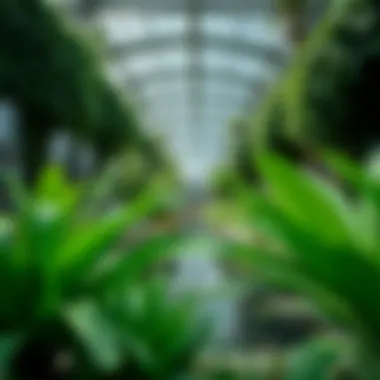
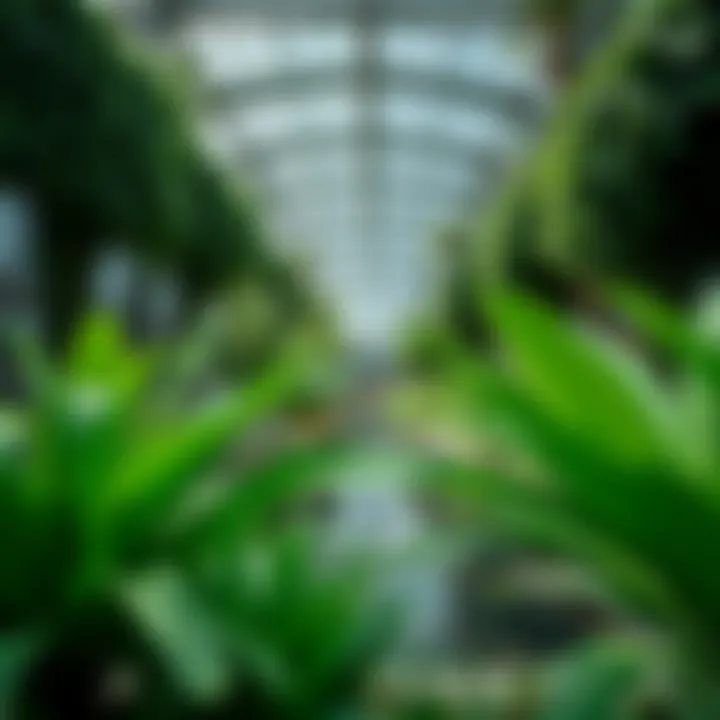
Intro
Dubai has made significant strides towards establishing itself as a global leader in sustainability. Amidst the glimmering skyscrapers and bustling city life, Green Planet City Walk emerges as a pivotal attraction, seamlessly melding architectural brilliance with ecological consciousness. This unique urban exhibit not only embodies the essence of sustainable living but also invites people to interact with nature in a way previously unseen in this desert metropolis.
Nestled within the vibrant City Walk district, this eco-friendly sanctuary offers a breath of fresh air, both literally and metaphorically. The surrounding urban landscape buzzes with activity, yet within the walls of The Green Planet, the experience transforms—visitors find themselves enveloped in lush greenery and vibrant ecosystems. This space aims to educate and inspire, showcasing the beauty and importance of conservation to a new generation.
As we traverse through this article, we’ll delve deeper into key market trends and insights that have influenced the development of such eco-centric projects in Dubai. Additionally, we'll uncover specific strategies for potential investors and individuals eager to become part of this green initiative, mixing nature and modern living in a city renowned for its innovation.
Let's embark on this journey to understand the Green Planet City Walk and its critical position as a beacon of sustainability in Dubai.
Prolusion to the Green Planet City Walk
The Green Planet City Walk serves as a superb example of how urban spaces can seamlessly intertwine with nature, presenting a model for sustainable urban development. It stands as more than just an attraction; it symbolizes Dubai's pledge towards eco-friendliness and environmental stewardship, offering both residents and tourists a unique glimpse into the interactions between mankind and nature. This introduction will explore the key elements and benefits that the Green Planet presents, ensuring a comprehensive perspective.
Background of the Project
The inception of the Green Planet dates back to Dubai’s vision of creating a sustainable environment and promoting green living. This ambitious project aims to foster an understanding of biodiversity and educate visitors about ecological responsibility. Located in the bustling hub of City Walk, the project utilizes a state-of-the-art facility that mimics a tropical rainforest. Natural sunlight nourishes its lush flora, while a controlled environment sustains various wildlife; all achieved without abandoning the surrounding urban infrastructure. Its innovative design arises from the need to offer a sanctuary of tranquility amidst the sometimes chaotic blend of a modern metropolis.
Objective of the Green Planet
The main objective of the Green Planet lies in its commitment to environmental education and awareness. It aims to create a space where people can not only appreciate but also learn about the vital ecosystems that exist both within the facility and around them. By integrating interactive experiences and engaging installations, visitors can readily grasp the complexities of biodiversity and sustainability. The Green Planet acts as a catalyst for eco-tourism, encouraging visitors to consider their impact on the environment while providing insights into sustainable living practices that can be applied even beyond their visit to Dubai.
"Sustainability isn't just a buzzword; it's a necessity for the urban world, and the Green Planet exemplifies this by turning ecological responsibility into an engaging experience."
With its strategic aim to inspire both young minds and seasoned environmental advocates, the Green Planet City Walk ultimately endeavors to shape the future of urban living in harmony with nature.
Architectural and Design Aspects
The architectural foundation of the Green Planet City Walk holds significant weight in understanding its environmental aspirations. This section seeks to dissect the underlying philosophies and concrete executions that contribute to the project's identity. Ultimately, the architecture is not merely about aesthetics; it embodies a vision of sustainability seamlessly integrated into the urban fabric. The materials used, layout choices, and spatial relationships all cooperate harmoniously to create a healthier urban ecosystem.
Innovative Biophilic Design
When discussing biophilic design, one shouldn't overlook its roots in human psychology and the intrinsic connection people have with nature. At the Green Planet City Walk, design elements interact rather effortlessly with their natural surroundings. Imagine spaces filled with living walls, abundant greenery, and water features that draw in not just the eye but the mind.
- Living Walls: The vertical gardens contribute to reducing indoor temperature and enhancing air quality. This element acts as a natural filter, ensuring fresh air flows through the entire facility. Moreover, they provide home to numerous small birds and insects, creating a micro-ecosystem.
- Natural Light Utilization: Strategic placements of windows and transparent roofing sections invite sunlight, reducing reliance on artificial lighting. Natural light boosts mood and has been shown to enhance cognitive performance, which is a benefit for both residents and employees.
- Water Features: The incorporation of water bodies within the design invites cooling breezes, ensuring a comfortable atmosphere even under the harsh desert sun. The sound of water trickling can soothe the mind, creating a tranquil environment amid busy urban life.
This innovative approach to design at the Green Planet serves as a model for other green spaces, proving that structural integrity and aesthetic beauty can coexist. Hints of natural elements evoke an innate calmness, reminding visitors and locals alike that nature is merely a step away.
Integration with City Walk
The integration of the Green Planet with City Walk is emblematic of a broader strategy to blend urban living with ecological consciousness. This melding of environments can be likened to a dance between man-made structures and nature. Key aspects to note include:
- Urban Oasis: The Green Planet acts as a serene retreat within the bustling City Walk, allowing visitors to escape into a natural setting without ever leaving the urban environment. This offers a unique juxtaposition of the concrete jungle contrasting with lush greenery.
- Cohesive Layout: The layout of the Green Planet supports foot traffic from City Walk, encouraging spontaneous visits. Well-planned pathways guide visitors through various exhibits while interacting thematically with the surrounding urban landscape.
- Bridging Spaces: Elements like shared parking lots and adjoining cafes maximize utility and enhance convenience. Visitors can seamlessly transition from shopping to nature without the need for complex navigation, promoting an ecosystem of leisure activities.
By knitting together the urban and the ecological, the Green Planet City Walk not only facilitates a delightful visitor experience but also sets a benchmark for future urban developments. As cities grow denser, examples like this will shape how future urban planning aligns with ecological principles.
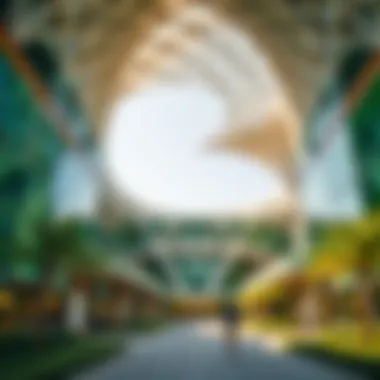
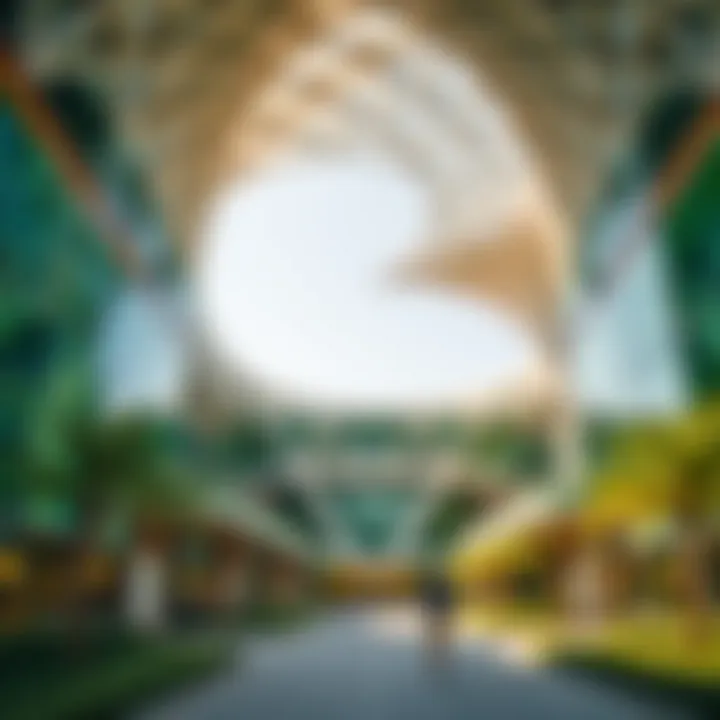
"Billions of people worldwide wish to reconnect with nature; the Green Planet is a beautiful testament to that yearning."
The architectural and design choices present a compelling narrative, pushing the boundaries of what urban spaces can achieve in marrying the man-made with the natural. With a focus on sustainable practices and thoughtful integration, it emphatically declares that the future of urban development lies in embracing ecological wisdom.
Ecological Significance
When talking about urban development, the term ecological significance often carries a weighty bag of connotations. Green Planet City Walk in Dubai stands out, not just as another pretty face in the ever-changing skyline but as an earnest attempt to rebalance the human-nature relationship in an urban setting.
Biodiversity in an Urban Setting
Urban areas are typically devoid of biodiversity, where concrete jungles make way for a monotonous backdrop lacking in rich ecosystems. However, Green Planet encourages a different approach. This initiative embraces both local flora and fauna, turning the tables on the common notion that cities are devoid of life.
Within its walls, you can find an array of plant species, many of which are indigenous to the region, showcasing their role in preserving genetic diversity and ecological integrity. For instance, the use of native plants is not only visually pleasing but immensely practical—they require less water and are more resilient to local pests. The design features free-standing trees and cascading waterfalls that mimic natural environments, and this versatility allows for habitats to thrive.
In addition to plants, the city walk hosts various animal species, including birds and insects. This careful curation of life is aimed at creating a comforting habitat where visitors can appreciate nature's beauty in the city's heart. These biodiversity niches bring natural order to a very ordered urban landscape, thereby reminding us of the essential threads that weave through our existence, even in a bustling metropolis.
"Fostering biodiversity isn’t just a luxury; it’s a necessity for our survival in urban spaces."
Sustainability Practices
Shifting gears, sustainability practices form the backbone of Green Planet’s operational structure, highlighting the importance of eco-friendly methodologies in daily life. The project doesn't just embrace sustainability; it lives and breathes it. Various aspects showcase how this urban oasis aims to educate, inspire, and implement sustainable practices within its framework.
For starters, water management plays a vital role in this initiative. Through rainwater harvesting and graywater recycling, the facility uses less water—a critical factor in arid regions like Dubai. Energy efficiency is another feather in its cap. The incorporation of solar panels and smart energy systems ensures that the operations run on sustainable energy, which not only reduces carbon footprints but serves as a model for future developments.
Also notable are the educational programs offered, which aim to inform visitors about sustainable practices. Here, kids and adults alike can learn about composting and waste management, emphasizing how even small actions can lead to big changes. These initiatives push the narrative beyond just a ‘go green’ movement, inspiring a lifestyle that prioritizes the health of the planet.
In sum, the Ecological Significance of Green Planet City Walk goes beyond aesthetics. It encapsulates an essential narrative about harmony between urban living and the ecological fabric of our world. It serves as a bold reminder that, in the quest for modern urban development, we can choose paths that are both sustainable and enriching.
Visitor Experience
The visitor experience at the Green Planet City Walk is a critical element that captures the essence of this innovative urban oasis. It’s not just about simply strolling through lush greenery; it's about engaging the senses and awakening a deeper consciousness towards sustainability. The various offerings create an environment where people can genuinely connect with nature, making it an essential destination for both tourists and residents alike.
Interactive Exhibits and Installations
One of the standout features of the Green Planet is its interactive exhibits and installations. These are tailored to make learning about ecology enjoyable. For instance, the immersive butterfly tunnel allows visitors to walk through a habitat that mimics tropical weather patterns, offering an intimate glimpse into the life cycle of these delicate creatures. The exhibits often change, ensuring that repeat visitors can rediscover something new.
The use of augmented reality in some displays allows guests to engage with information in a hands-on manner. As people scan QR codes on different flora and fauna, they can access educational content detailing the species' contributions to the ecosystem. Such initiatives enrich the visit by transforming passive observation into active learning, which is quite significant in today's fast-paced world. Additionally, young children can participate in workshops that encourage creativity while also propagating ideas about the environment, making it a wholesome family-friendly experience.
"In an age where technology overshadows nature, these interactive components help bridge that gap and kindle a renewed appreciation for the environment."
Engagement with Nature
The engagement with nature here transcends the conventional park visit. Unlike somewhere where your interaction with greenery is muted by barriers, Green Planetists are encouraged to touch, smell and truly live within nature. The carefully landscaped areas fool the senses, mimicking a tropical rainforest complete with waterfalls and ambient sounds of wildlife.
Visitors can participate in guided tours to learn not only about the diverse species within the biome but also about the importance of biodiversity in urban settings. Experiences such as feeding various animals or participating in tree planting initiatives foster a sense of stewardship towards the environment. Moreover, the space offers quiet meditation zones, creating opportunities for mindful reflection amidst the hustle and bustle typical of urban life.
When considering the broader impact, the experience cultivated at the Green Planet goes beyond pleasure—it's about sowing the seeds for future conservation. This comprehensive approach is what sets Green Planet apart, aligning perfectly with Dubai’s vision of sustainable urban living. Visitors leave not only with memorable experiences but also with a greater understanding of their role in preserving the environment.
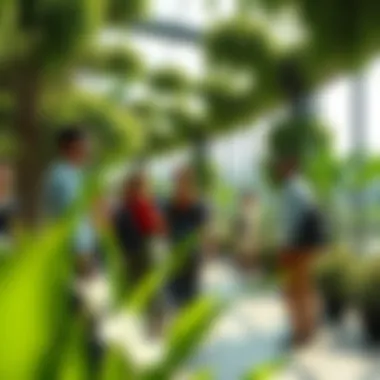
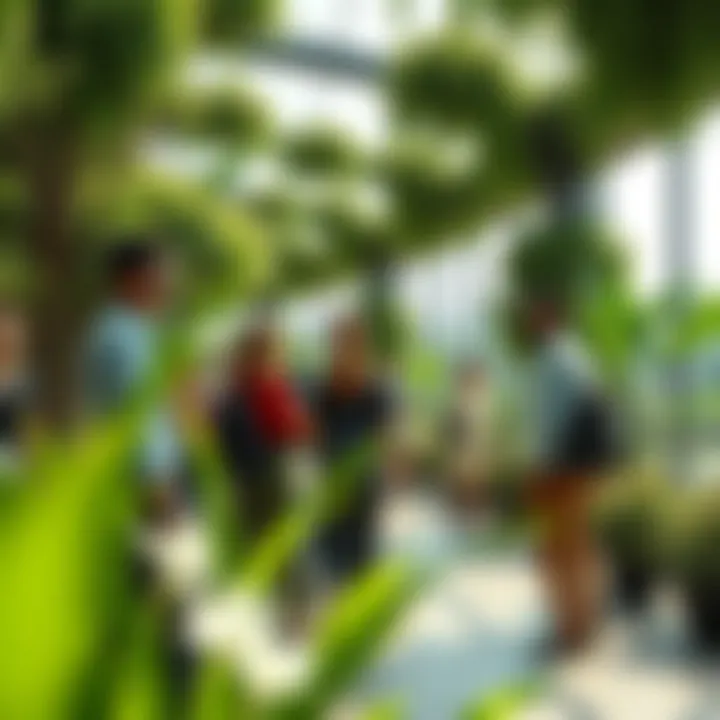
Tourism and Economic Impact
The expansion of eco-friendly initiatives in urban settings like Dubai’s Green Planet City Walk represents a significant turning point for the tourism landscape and overall economic health of the region. In an era where global awareness of environmental issues is growing, the need to attract environmentally conscious tourists cannot be overstated. The City Walk not only serves as a popular attraction but also positions itself as a key player in the broader movement towards sustainable tourism.
Tourism here isn't just about sightseeing; it's about creating experiences that resonate with a growing segment of travelers who prioritize sustainability and ethical consumption. This initiative offers a unique blend of natural beauty and innovative urban design, enticing visitors who seek out places where they can connect with nature amidst modern architecture.
Attracting Eco-Tourism in Dubai
The allure of the Green Planet City Walk lies in its diverse offerings that promote eco-tourism. This endeavor not only attracts visitors but nurtures a sense of responsibility toward environmental preservation. As the world gravitates towards destinations that advocate for sustainability, Dubai has recognized the importance of aligning with these values.
Some of the features drawing in eco-conscious tourists include:
- Educational Programs: Visitors can engage in learning opportunities about biodiversity, conservation initiatives, and local flora and fauna.
- Sustainable Interactions: The City Walk provides a platform where concrete urban life juxtaposes with vibrant greenery, inviting tourists to experience nature firsthand without leaving an ecological footprint.
- Community Events: Regularly scheduled sustainability workshops and eco-friendly events keep the buzz alive, drawing repeat visitors who wish to be part of these communal experiences.
By incorporating sustainability into its branding, the Green Planet City Walk enhances Dubai’s reputation as a premier eco-tourism destination. Increased foot traffic contributes to the overall economy while encouraging local businesses to adopt greener practices as part of their operation.
Investment Potential for Real Estate
The positive economic ripple effect of the Green Planet City Walk extends well beyond tourism alone; it opens up significant opportunities for real estate investment within the framework of urban sustainability. The growing interest in eco-friendly communities stimulates the demand for properties that offer access to green spaces and sustainable living options.
Real estate investors and developers should consider several factors:
- Rising Demand: With eco-tourism gaining traction, properties near the City Walk are seeing an uptick in interest from potential buyers and renters alike. This demand is likely to drive property values up over time.
- Sustainable Developments: Investors can capitalize on the trend by focusing on projects that embrace green building certifications such as LEED, which appeal to environmentally aware consumers.
- Long-Term Viability: Projects that integrate nature into their design not only enhance the aesthetic appeal but also contribute positively to residents’ well-being, thus ensuring sustained interest in these developments.
Despite some challenges in initial outlays and specific regulatory hurdles regarding eco-compliant structures, the long-term benefits outweigh these cons. Investors interested in Dubai’s evolving landscape would be wise to keep an eye on the Green Planet as a beacon for future initiatives and investments.
The economic impact of the Green Planet City Walk highlights the intersection between ecological stewardship and urban development, making it a pivotal model for cities worldwide as they embrace both tourism and environmental responsibility.
The Role of Green Initiatives in Dubai's Urban Planning
Dubai, with its soaring skyscrapers and bustling lifestyle, has made significant strides toward incorporating green initiatives in its urban planning. The city recognizes that maintaining an ecological balance is essential, not just for the environment, but also for the quality of life of its residents. Thus, these initiatives often intersect with advancements in urban development, creating more sustainable living spaces.
Creating public green spaces and facilities like the Green Planet City Walk serves multiple purposes: enhancing biodiversity, improving air quality, and promoting community interaction. Urban planning that emphasizes these elements fosters an environment where nature thrives alongside modernity, something that is crucial in a city known for its cutting-edge architectural feats.
Green initiatives also align with global sustainability efforts, positioning Dubai as a leader in eco-friendly practices. Ultimately, they form the backbone of a city that aspires to achieve a balance between urban development and environmental conservation.
Alignment with Dubai Vision
Dubai's Vision 2021 emphasizes the importance of sustainability in its growth framework. The leadership envisions an advanced society having a high quality of life, one that harmoniously blends development with green spaces. This vision supports the initiative of urban parks, diverse ecosystems, and green residential facilities. The emphasis on creating sustainable urban areas speaks to a broader commitment toward a "smart city" that prioritizes both technology and nature.
In line with Dubai’s vision, strategies include:
- Expansion of urban parks and gardens
- Investments in renewable energy projects
- Development of sustainable architecture
- Encouraging electric transportation and bike-sharing systems.
All these elements come together to enhance not only the urban landscape but also to instill a sense of environmental responsibility among residents and businesses alike.
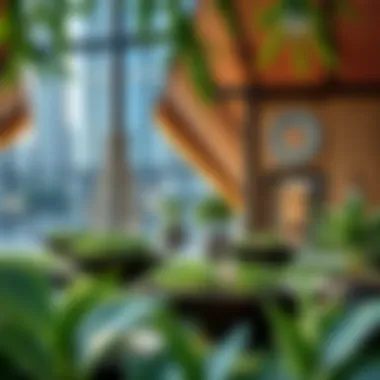
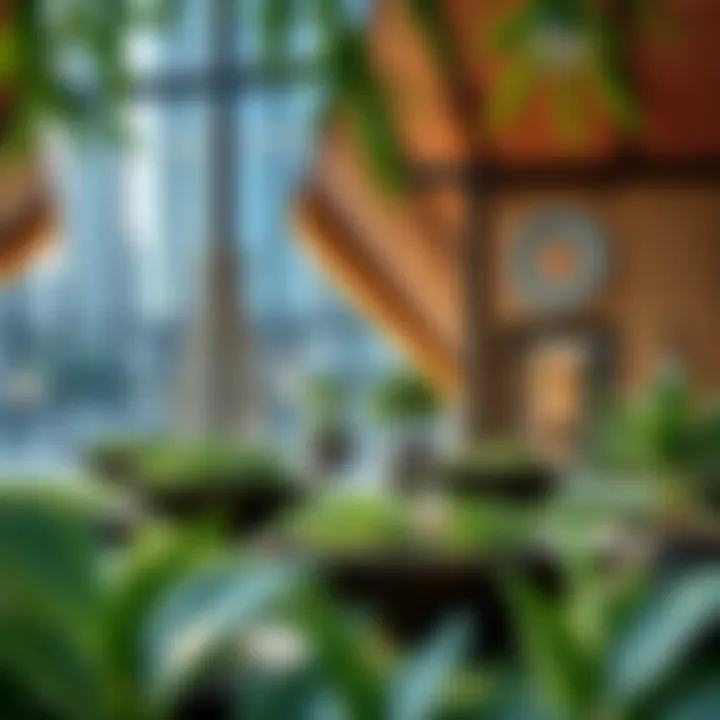
Future Green Projects
As Dubai continues on its sustainable journey, various future green projects are lined up that promise to further revolutionize urban living. Projects may include future eco-parks, green rooftops, and vertical gardens that not only beautify the environment but also contribute to improved air quality and biodiversity.
Some key future green initiatives can focus on:
- Vertical Farms: Integrating agriculture into urban settings to provide locally sourced food while reducing transportation emissions.
- Community Gardens: Spaces for residents to grow produce, thereby encouraging community engagement and awareness of sustainability.
- Enhanced Public Transport: Increasing access to renewable energy-powered transportation systems to reduce reliance on fossil fuels.
- Renewable Energy Facilities: Expanding solar and wind energy sources to power public amenities.
The ongoing efforts in sustainable urban planning reveal Dubai's commitment to creating an oasis that marries luxury living with environmental consciousness.
In summary, as Dubai forges ahead with its eco-friendly projects, the city sets a precedent that could inspire other urban centers around the globe, balancing innovation and ecology. Such initiatives certainly contribute to enhancing the city's image while attracting investors and eco-conscious residents.
Challenges and Considerations
In the context of the Green Planet City Walk, addressing the challenges and considerations becomes essential. Building this urban oasis wasn’t merely a walk in the park; it involves navigating complex environmental issues, integrating technology, and managing the expectations of a rapidly evolving urban community. The commitment to creating a sustainable city space means the project consistently reassesses its practices to adapt to new insights and pressures.
Environmental Challenges
The environmental challenges faced are numerous. From air and water quality to habitat preservation, each aspect requires careful monitoring. One primary issue in this region is water scarcity. The construction of a lush ecosystem in a desert landscape demands innovative water management strategies. While the City Walk itself is an impressive feat of engineering, it necessitates sustainable water usage practices. Technologies like drip irrigation and greywater recycling come into play, ensuring that the “green” in Green Planet doesn’t lead to grey waste.
- Heat management is also a significant factor. The expansive glass structures can amplify heat, impacting not just the building's energy efficiency but also the broader local climate. Implementing cooling systems that minimizes energy usage stands critical, for both sustainability and financial reasons.
- Further, biodiversity is another environmental point. With an increasing urban footprint, the challenge lies in preserving local flora and fauna while introducing exotic species without overstepping ecological boundaries.
The proactive stance adopted by the planners and designers to handle these concerns suggests a forward-thinking approach that acknowledges their responsibilities in nature conservation, thus providing a model for future projects.
Maintenance of Eco-Systems
Maintenance of ecosystems within the Green Planet is paramount. This task goes hand-in-hand with environmental considerations and requires continuous effort, much like tending to a garden. Each species and the specific biomes need to be evaluated regularly to ensure their health and vitality.
- Regular assessments are crucial. Environmental specialists conduct checks on plant health, address potential pest issues, and monitor the interaction between species to maintain balance. This database of information serves as a guidebook for the care and future adjustments needed in the ecosystem.
- Moreover, educating the employees around this area about best practices in ecosystem management fosters a sense of stewardship and responsibility with those actively involved in upkeep activities.
- The introduction of community programs also plays a role; involving the public helps to reinforce environmental awareness. Local workshops that illustrate the intricate connections between urban and natural environments can enrich the understanding and appreciation of the significance of these ecosystems.
"Sustainability in urban development isn't just a goal; it's an ongoing commitment to nurturing the delicate balances of our environments."
By tackling these challenges with purpose and dedication, the Green Planet City Walk stands not just as a picturesque attraction but as an exemplar of how cities can evolve to harmonize with nature, demonstrating that a balance between progress and preservation is not just essential, but achievable.
Ending
Revisiting the importance of the Green Planet City Walk in this article helps us appreciate not just its stunning architecture but its broader implications for sustainable living in urban settings. This initiative is not merely a visual treat; it serves as a pivotal example of how cities can embrace eco-friendliness without sacrificing modern comforts. Understanding the intricacies of the sustainable practices employed here provides insight into how urban planners and environmental advocates can collaborate to foster development that aligns with ecological longevity.
Summary of Key Insights
Throughout our exploration of the Green Planet City Walk, several crucial insights have emerged:
- Integration of Nature and Urban Life: The project epitomizes how nature can thrive alongside urbanity. It's a breath of fresh air in the middle of a bustling metropolis.
- Innovative Design: The biophilic design encourages a harmonious relationship between residents and their environment. This can encourage cities worldwide to rethink their own architectural approaches.
- Ecological Education: Visitors leave with a greater understanding of biodiversity and conservation, fostering a culture of environmental awareness.
- Economic Opportunities: The development not only draws tourists but also significant investments in related sectors such as real estate and eco-tourism.
These points reflect how the initiative contributes meaningfully to a more sustainable and livable Dubai.
Future Prospects for Green Urban Development
Looking ahead, the prospects for green urban development remain bright, not only for the Green Planet City Walk but also for similar initiatives across Dubai and beyond. As the urgency for sustainable practices grows, we can expect:
- More integration of green spaces into urban planning, leading to improved mental and physical health among residents.
- Technological advances in sustainable construction methods that could drive down costs and enhance efficiency in the building industry.
- Increased public-private partnerships to fund and develop eco-friendly projects, ensuring their viability and sustainability.
- Community engagement initiatives to educate the public about sustainable living, drawing in more participants who care about the environment.
The horizon is indeed expanding for environmentally focused urban initiatives, positioning cities worldwide to follow suit and potentially revolutionizing global approaches to urban living.







